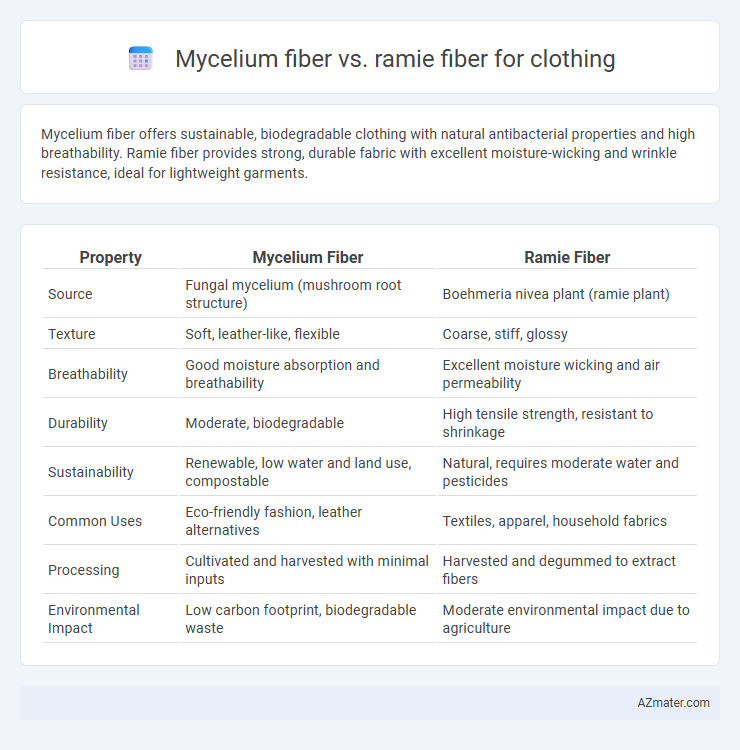Mycelium fiber offers sustainable, biodegradable clothing with natural antibacterial properties and high breathability. Ramie fiber provides strong, durable fabric with excellent moisture-wicking and wrinkle resistance, ideal for lightweight garments.
Table of Comparison
| Property | Mycelium Fiber | Ramie Fiber |
|---|---|---|
| Source | Fungal mycelium (mushroom root structure) | Boehmeria nivea plant (ramie plant) |
| Texture | Soft, leather-like, flexible | Coarse, stiff, glossy |
| Breathability | Good moisture absorption and breathability | Excellent moisture wicking and air permeability |
| Durability | Moderate, biodegradable | High tensile strength, resistant to shrinkage |
| Sustainability | Renewable, low water and land use, compostable | Natural, requires moderate water and pesticides |
| Common Uses | Eco-friendly fashion, leather alternatives | Textiles, apparel, household fabrics |
| Processing | Cultivated and harvested with minimal inputs | Harvested and degummed to extract fibers |
| Environmental Impact | Low carbon footprint, biodegradable waste | Moderate environmental impact due to agriculture |
Introduction to Mycelium and Ramie Fibers
Mycelium fiber, derived from fungal root structures, offers a sustainable alternative with biodegradable and lightweight properties, making it ideal for eco-friendly clothing. Ramie fiber, extracted from the stalks of the Boehmeria plant, is known for its durability, breathability, and natural luster, widely used in textile production for strength and comfort. Both fibers represent innovative choices in sustainable fashion, with Mycelium emphasizing environmental benefits and Ramie focusing on traditional textile qualities.
Origins and Production Processes
Mycelium fiber is derived from the root structure of fungi, cultivated through a sustainable, low-impact fermentation process that transforms mycelium into a soft, leather-like material suitable for clothing. Ramie fiber originates from the stalks of the Boehmeria nivea plant, primarily grown in East Asia, and undergoes retting, degumming, and combing to produce a natural, lustrous textile fiber known for its strength and breathability. The production of mycelium fiber emphasizes renewable biofabrication, whereas ramie fiber relies on traditional agricultural harvesting and extensive chemical processing to prepare fibers for fabric manufacturing.
Environmental Impact Comparison
Mycelium fiber and ramie fiber both offer sustainable alternatives to conventional textiles, but their environmental impacts differ significantly. Mycelium fiber is derived from fungal mycelium, requiring minimal water and pesticides, and it biodegrades rapidly with a low carbon footprint. Ramie fiber, sourced from the stalks of the ramie plant, involves more water usage and chemical processing, though it remains biodegradable and has a moderate environmental impact compared to cotton.
Fiber Structure and Physical Properties
Mycelium fiber exhibits a unique cellular network structure derived from fungal hyphae, offering high biodegradability and flexibility with moderate tensile strength, ideal for sustainable clothing applications. Ramie fiber, sourced from the stalks of the Boehmeria plant, features long, coarse, and lustrous cellulose filaments known for exceptional tensile strength, durability, and moisture absorption, enhancing fabric longevity and comfort. While mycelium fiber provides lightweight breathability and eco-friendliness, ramie offers superior rigidity and resistance to microbial attack, making a blend of both fibers promising for innovative textile development.
Durability and Longevity in Garments
Mycelium fiber offers exceptional durability due to its natural resilience and ability to resist wear and tear, making it a strong alternative for long-lasting garments. Ramie fiber, known for its high tensile strength and resistance to stretching, also provides excellent longevity in clothing, especially in maintaining fabric integrity over time. Both fibers enhance garment durability, but ramie excels in moisture resistance, while mycelium fiber stands out for its eco-friendly biodegradability and structural robustness.
Comfort, Breathability, and Skin Sensitivity
Mycelium fiber offers exceptional breathability and moisture-wicking properties, making it highly comfortable for clothing, especially in warm climates. Ramie fiber is known for its strength and smooth texture, providing a cool, crisp feel ideal for sensitive skin but can sometimes lack the softness found in plant-based alternatives. Both fibers excel in skin sensitivity, but Mycelium's natural antifungal properties enhance comfort and reduce irritation risks during prolonged wear.
Aesthetic and Design Versatility
Mycelium fiber offers a unique, sustainable aesthetic with a smooth yet slightly textured surface that can be dyed easily, making it ideal for innovative fashion designs seeking an eco-friendly edge. Ramie fiber boasts a natural luster and crisp feel, providing excellent drape and structure, perfect for garments requiring a refined, polished appearance. Both fibers enable diverse design possibilities, with mycelium excelling in avant-garde and experimental apparel, while ramie suits classic, breathable clothing with a luxurious finish.
Biodegradability and End-of-Life Options
Mycelium fiber offers superior biodegradability compared to ramie fiber, breaking down naturally within weeks under composting conditions due to its organic fungal origin. Ramie fiber, derived from the stalks of the Boehmeria plant, also biodegrades but at a slower rate, often requiring months to decompose fully in soil environments. End-of-life options for mycelium clothing typically include industrial composting and home composting, whereas ramie garments may be recycled or repurposed but often end up in landfills due to limited industrial recycling facilities.
Cost and Market Availability
Mycelium fiber, derived from fungal mycelium, is an emerging sustainable material with limited market availability and generally higher production costs due to novel processing techniques. Ramie fiber, a traditional plant-based textile fiber, boasts widespread availability and lower costs, benefiting from established cultivation and manufacturing infrastructure. The price gap and supply chain maturity make Ramie a more accessible choice for mass-market clothing, while Mycelium fiber suits niche markets prioritizing innovation and eco-friendly fibers.
Future Prospects and Sustainability Potential
Mycelium fiber offers innovative sustainability potential due to its biodegradability, low water usage, and ability to be grown rapidly with minimal environmental impact, positioning it as a promising alternative for eco-friendly clothing. Ramie fiber, derived from the flowering plant Boehmeria nivea, is a strong, natural fiber with excellent moisture-wicking properties and is biodegradable, but it requires more water and chemicals for processing compared to mycelium. Future prospects for mycelium in textiles emphasize scalable cultivation and enhanced durability, while ramie remains valued for blending with other fibers to improve fabric strength and sustainability in traditional textile manufacturing.

Infographic: Mycelium fiber vs Ramie fiber for Clothing
 azmater.com
azmater.com